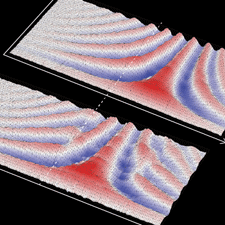Three-dimensional manipulation of electron spin without use of magnetic field
“Mobile spin resonance” - promising new technique for quantum computation

NTT Basic Research Laboratories and Tohoku University have discovered a novel phenomenon "mobile spin resonance" in collaboration with the Paul Drude Institute for Solid-State Electronics. This finding enables us to achieve three-dimensional manipulation of trajectory-controlled electron spin*1 without the use of external magnetic fields, and consequently will provide an efficient and simple way of manipulating quantum information toward the realization of a future quantum computer*2. A research paper describing these results appeared as an Advance Online Publication in Nature Physics on March 17, 2013. (See also News and Views about it.) This work was supported by Grants-in-Aid for Scientific Research from the Japan Society for Promotion of Science (JSPS).
=> Press Release
=> Quantum Optical Physics Research Group
Electron spin in semiconductors are expected to act as quantum information carriers in solid state quantum computers. The most promising approach for spin control is based on electron spin resonance (ESR)*3, a technique commonly used both in research and for practical applications. However, the previously proposed spin manipulation methods based on ESR require external magnetic fields, which are generated in spaces that greatly exceed the size of individual electrons, thus making these complex and inefficient techniques unsuitable for device applications.
To address this challenge, the research team has discovered a novel phenomenon named "mobile spin resonance". The mobile spin resonance uses spin-orbit interaction*4, which is known to produce a non-real (effective) magnetic field that is experienced by the moving electrons themselves (Fig.1). The research team has developed their original technique (reported in 2011) that enables the control of spin-orbit interaction with ultrasonic waves (Fig. 2), and succeeded in observing the spin behavior of ESR even in the absence of external magnetic fields (Fig. 3). This phenomenon allows us to manipulate spins in any three-dimensional direction by designing appropriate channel structures.
The magnetic-field-free operation demonstrated here changes the general concept of the widely accepted ESR mechanism. For the future, we are planning to develop the present technique by attempting to achieve single spin manipulation and entanglement control between multi-electron spins, and then use them as basic elements in quantum information technology.

Figure 1: Comparison between conventional ESR and mobile spin resonance
Mobile spin resonance uses spin-orbit effective magnetic fields instead of external magnetic fields. Because the effective magnetic field depends on the electron’s velocity, we can produce both static and oscillating effective magnetic fields simultaneously by properly controlling the trajectory of the moving electrons.

Figure 2: Control of electron trajectories using dynamic dots
The sample was a semiconductor quantum well*5 structure, on which a metal film with slits was deposited. A surface acoustic wave (SAW)*6 beam propagating along the sample surface produces local piezoelectric field*7 in the quantum well. The metal film partially screens the piezoelectric fields in the area other than the channel formed beneath the slit. The resultant confinement potentials (dynamic dots) transport electrons along the channel determined by the shape of the slits.

Figure 3: Observation of mobile spin resonance with magneto-optic Kerr effect*8
The graphs show the spin distributions measured for the spin transport along straight and winding channels in the absence of external magnetic fields. The image for the winding channel revealed spin Rabi rotation*9, which is characteristic behavior of ESR.
Glossary
*1 Electron spin
An electron has a property of a small magnet. This property is called 'spin' by analogy with the rotation of a classical sphere. The spin is treated as a quantum mechanical state and represented by a vector in a three-dimensional space.
*2 Quantum computer
A quantum computer is a computer that operates with “quantum bits (qubits)” based on physical systems that are governed by quantum mechanics. The quantum computer can use the superposition of the quantum states, and therefore can solve certain problems (e.g. integer factorization, database search) much faster than a classical computer.
*3 Electron spin resonance: ESR
ESR is a phenomenon that occurs with a spin placed in static and oscillating magnetic fields under a certain condition, namely the energy of the oscillating field must match the spin-splitting energy determined by the static field.
*4 Spin-orbit interaction
Spin-orbit interaction is a relativistic effect that produces an effective magnetic field for an electron moving in an electric field. The spin-orbit interaction in semiconductors is mainly induced by crystal fields and externally applied voltage.
*5 Quantum well
A quantum well is a layered structure of semiconductors, where a quantum well layer with a small potential energy is sandwiched between barrier layers with a larger potential energy. We can confine electrons effectively in the quantum well layer.
*6 Surface acoustic wave: SAW
SAW is an acoustic wave that travels along the surface of an elastic body. In piezo-electric materials, such as GaAs, the local strain induced by the SAW produces local piezoelectric fields.
*7 Piezoelectric field
In materials called "piezo materials", an external strain induces dielectric polarization. The resultant electric field is called a "piezoelectric field"
*8 Magneto-optic Kerr effect
The polarization of the light reflected from a magnetized material rotates slightly from the original polarization. This is called Magneto-optic Kerr effect. In the present research, the Kerr rotation angle is proportional to the spin component in the direction perpendicular to the sample plane.
*9 Rabi rotation
When the static and oscillating magnetic fields match the spin-resonance condition, the trajectory of the spin vector traces the surface of a three-dimensional sphere. This spin motion is called Rabi rotation.










